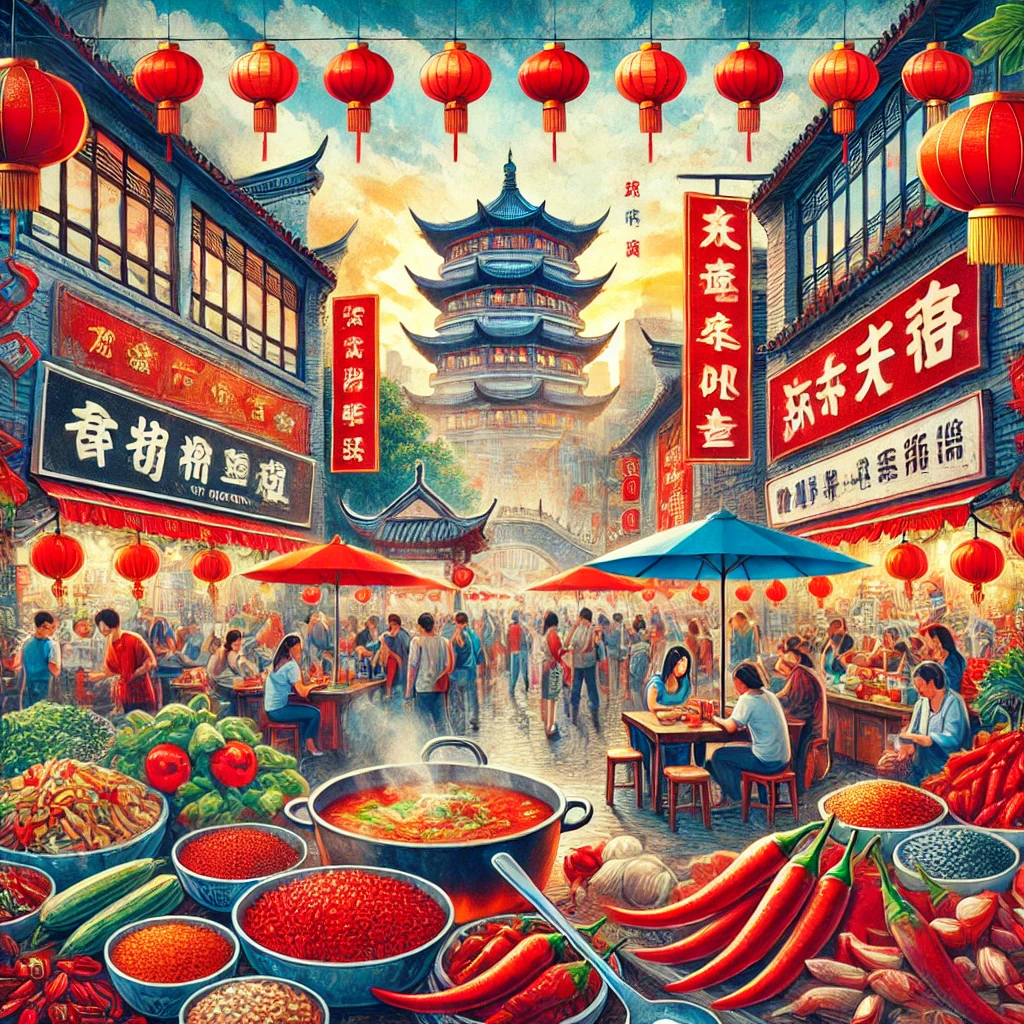Table of Contents
Introduction to China’s Hidden Treasures
As one of the world’s oldest civilizations, China boasts a rich tapestry of history, culture, and natural beauty that extends far beyond the bustling streets of Shanghai. While major cities like Shanghai attract millions of tourists with their iconic landmarks and vibrant urban life, there exists a myriad of lesser-known destinations waiting to be explored. These hidden gems offer travelers an opportunity to delve deeper into the essence of China, showcasing unique cultural experiences and breathtaking landscapes that are often overshadowed by more renowned sites.
Exploring these off-the-beaten-path locales allows visitors to step away from the crowds and experience the authentic charm of the country. From tranquil villages nestled among picturesque mountains to ancient temples tucked away in serene forests, these destinations promise a unique perspective on China’s diverse heritage. Each hidden treasure tells a story, enriching the travel experience with personal narratives and local customs that offer a more profound connection to the region’s history.
The allure of venturing beyond the well-trodden tourist trail lies not only in discovering stunning views and historical relics but also in engaging with the local communities. Travelers can savor regional delicacies, participate in traditional festivals, and witness age-old crafts, all of which provide insight into the daily lives of the people who call these lesser-known areas home. By prioritizing these hidden gems, visitors can foster a deeper appreciation for China’s cultural depth and diversity, ultimately redefining their travel experience.
In this exploration of China’s hidden treasures, we invite you to discover must-visit spots that capture the heart and soul of this vast nation, promising memorable adventures that linger long after the journey has ended.
The Charm of Hangzhou: A City of Serenity
Located in the eastern part of China, Hangzhou is often celebrated for its serene beauty and historical significance. The city is best known for the picturesque West Lake (Xihu), which has been a source of inspiration for poets and artists throughout centuries. This iconic lake, with its lush greenery and scenic vistas, offers visitors a tranquil escape from the hustle and bustle of urban life. The surrounding areas feature picturesque pagodas, bridges, and willow-lined paths, making it a popular spot for both leisurely walks and boat rides.
Beyond the visual appeal, Hangzhou is deeply rooted in traditional culture, particularly in its famous tea industry. The nearby Longjing (Dragon Well) tea plantations provide a unique opportunity to explore the delicate process of tea cultivation. Visitors can engage in tea tasting sessions, where they will learn about the art of preparing and enjoying one of China’s most renowned teas. This local tea culture is intertwined with the city’s identity, showcasing its commitment to preserving rich culinary traditions.

Among the must-visit attractions, the Lingyin Temple stands out as a sublime testament to Hangzhou’s spiritual heritage. As one of the oldest and wealthiest Buddhist temples in China, it boasts exquisite architecture and a serene ambiance, allowing visitors to reflect and experience tranquility. Additionally, the Xihu Scenic Area is a highlight for any traveler seeking solace in nature, providing various viewpoints for breathtaking panoramas of the lake, especially during sunrise or sunset.
Overall, Hangzhou presents an alluring blend of history, culture, and nature, which makes it a prime destination for those seeking a serene getaway. Whether you are walking around West Lake or sampling the local cuisine, the charm of Hangzhou is sure to leave a lasting impression.
Exploring the Ancient Towns of Wuzhen and Zhouzhuang
The ancient water towns of Wuzhen and Zhouzhuang are exquisite examples of China’s rich cultural heritage, attracting visitors with their unique architecture and historical significance. Nestled in Jiangsu and Zhejiang provinces, these towns embody the traditional lifestyle of the region, characterized by winding canals, stone bridges, and well-preserved wooden houses. As one strolls through the narrow alleyways, it becomes apparent that Wuzhen and Zhouzhuang have effectively preserved their architectural integrity, reflecting styles that date back several centuries.

In Wuzhen, visitors can enjoy serene boat rides along the picturesque canals that crisscross the town. These boat rides offer a tranquil way to observe the daily lives of local residents, which often revolve around activities such as fishing and farming. The charming scenery, accompanied by the soft sounds of water lapping against the boats, creates an enchanting atmosphere, allowing one to embrace the essence of traditional Chinese culture. Similarly, Zhouzhuang boasts an intricate network of waterways dotted with old wooden boats, making it another ideal destination for a leisurely aquatic journey.
Cultural festivals in these ancient towns further enhance their allure. Events such as the Wuzhen Theatre Festival and the Dragon Boat Festival showcase local performers and traditional customs, enriching the visitor experience. Additionally, local crafts such as silk weaving and bamboo carving can be observed in action, providing an insight into the artisanal skills that have been passed down through generations. These experiences not only highlight the unique characteristics of Wuzhen and Zhouzhuang but also allow visitors to engage with and appreciate the traditional Chinese way of life.
The Stunning Landscapes of Zhangjiajie National Forest Park
Zhangjiajie National Forest Park, a UNESCO World Heritage Site located in Hunan Province, is renowned for its stunning landscapes characterized by towering vertical rock formations. These unique geological structures, which rise dramatically from the ground, create a surreal environment that captivates visitors. The park’s dramatic scenery and distinct ecosystem make it a prime destination for nature enthusiasts and adventure seekers alike.
One of the key features of Zhangjiajie National Forest Park is its intricate network of hiking trails that cater to various skill levels. Trails meander through lush greenery, often leading hikers to breathtaking viewpoints that showcase the park’s natural beauty. Among the most exhilarating experiences is the glass skywalk, which extends along the cliff face, providing an unparalleled view of the expansive valleys below. This transparent walkway allows visitors to feel as though they are walking on air, enhancing the connection to the stunning landscapes that define this remarkable area.

The park’s unique geological formations served as an inspiration for the floating mountains depicted in James Cameron’s film “Avatar.” The otherworldly beauty of Zhangjiajie not only stirs imagination but also draws attention to the area’s ecological significance. Rich in biodiversity, the park is home to numerous endemic plant and animal species, making it an important location for ecological study and conservation efforts.
Visitors to Zhangjiajie National Forest Park are encouraged to explore the trails, savor thrilling outdoor activities, and immerse themselves in the captivating landscapes. With its rugged cliffs, ethereal scenery, and diverse ecosystems, Zhangjiajie National Forest Park stands as a testament to the natural wonders that China has to offer, showcasing the remarkable beauty of its hidden gems beyond Shanghai.
Discovering the Rich Cultural Heritage of Dunhuang
Dunhuang, often regarded as a treasure trove of Chinese cultural heritage, is most famously known for the Mogao Caves, a UNESCO World Heritage Site that captivates visitors with its stunning artistic achievements. Dating back to the 4th century, the Mogao Caves are a complex of rock-cut caves adorned with intricate murals and sculptures that reflect the development of Buddhist art over a millennium. These artworks serve not only as exceptional examples of artistic expression but also as significant historical documents that chart the evolution of Buddhist beliefs and practices in the region.

The murals found within the caves are particularly remarkable, showcasing a wide array of themes ranging from religious iconography to scenes of everyday life during the time. Visitors can witness a stunning array of colors and stylistic techniques that vary across different periods, revealing the influences from various cultures that traversed the ancient Silk Road. This trade route, which connected the East and West, enabled a rich exchange of ideas, goods, and beliefs, making Dunhuang an essential hub of cultural interaction.
To fully appreciate the depth of history and artistry at the Mogao Caves, engaging in guided tours is highly recommended. Knowledgeable guides offer invaluable insights into the significance of the caves, diving into stories of the monks who once inhabited the area and the travelers who passed through seeking spiritual enlightenment. Additionally, some tours provide access to cave interiors that are usually closed to the general public, allowing for a more intimate experience with the art and culture that defines Dunhuang.
Overall, a visit to Dunhuang and the Mogao Caves promises not only to expand one’s understanding of Buddhist art but also to illuminate the profound historical legacy of the Silk Road, making it a must-visit destination for those seeking to explore China’s rich cultural heritage.
Experiencing the Quaint Town of Lijiang
Lijiang, a UNESCO World Heritage city nestled in the Yunnan province of China, is renowned for its rich tapestry of cultures, ancient architecture, and stunning natural surroundings. This picturesque town is a veritable treasure, often overshadowed by larger cities like Shanghai, yet offers a unique glimpse into China’s diverse heritage. The ancient town features well-preserved buildings that showcase traditional Naxi architecture, characterized by its unique wooden structures with intricate carvings and distinctive roofs. Strolling through the cobblestone streets, visitors are enveloped in the charm of Lijiang, where time-honored traditions effortlessly blend with a serene atmosphere.

Lijiang is home to the Naxi people, an ethnic minority with a compelling culture that distinguishes it from other regions in China. The Naxi culture is deeply rooted in animism, and visitors can experience its vibrant customs, including music, dance, and art. The Naxi orchestra is particularly noteworthy; its performances typically feature traditional instruments that produce hauntingly beautiful melodies. Participating in such cultural encounters provides an enriching understanding of the Naxi’s way of life, allowing travelers to appreciate the nuances of their traditions and beliefs.
One of the most striking features of Lijiang is its breathtaking natural landscape, most prominently the imposing Jade Dragon Snow Mountain. This majestic range, often capped with shimmering white snow, offers numerous hiking opportunities for outdoor enthusiasts and nature aficionados. The surrounding parks and trails provide picturesque views and serene environments, perfect for relaxation or exploration. Lijiang serves not only as a gateway to Jinsha River, but also as a base to discover more of Yunnan’s stunning scenery. Ultimately, this quaint town holds untold wonders worth exploring, embodying the rich history and cultural diversity that permeates through the essence of China.
The Unique Culture of Xi’an and the Terracotta Warriors
Xi’an, one of China’s most historically rich cities, served as a significant capital during several dynasties, including the Qin, Han, and Tang. It is widely recognized as the starting point of the Silk Road, which facilitated cultural and commercial exchange between East and West. This city, steeped in history, offers visitors an opportunity to delve into the unique culture of ancient China while exploring its many attractions.
Among Xi’an’s most notable landmarks is the Terracotta Army, a remarkable archaeological find that dates back to the third century BCE. Discovered in 1974 by local farmers, this vast collection of terracotta sculptures was commissioned by Emperor Qin Shi Huang to accompany him in the afterlife. Comprising thousands of life-sized figures, including warriors, horses, and chariots, the Terracotta Army is not only a testament to ancient artistry but also provides insight into the military might and beliefs of the time. The site’s archaeological significance has earned it a UNESCO World Heritage designation, attracting thousands of visitors each year.

In addition to the Terracotta Warriors, Xi’an boasts several other cultural attractions that reflect its rich heritage. The ancient City Wall, one of the best-preserved city walls in China, encircles the city and offers a unique glimpse into medieval defense architecture. Visitors can walk or cycle along its expansive perimeter, enjoying views of both the city and its ancient structures. Another cultural highlight is the Muslim Quarter, a vibrant area known for its bustling markets, diverse cuisine, and significant Islamic architecture. Here, visitors can experience the harmonious coexistence of different cultures and traditions, with the tantalizing aromas of street food wafting through the air.
Exploring Xi’an is akin to stepping back in time, where ancient customs and modern life converge, making it a vital destination for anyone interested in China’s unique cultural tapestry.
Food Adventures in Chengdu: The Land of Spice
Chengdu, the capital of Sichuan Province, is renowned not only for its stunning landscapes and historical sites but also as a culinary haven, particularly celebrated for its spicy and flavorful Sichuan cuisine. Visitors to this vibrant city should brace themselves for an unforgettable food journey where every meal presents an opportunity to explore unique flavors and aromas. At the heart of Chengdu’s culinary landscape are a few must-try dishes that define the local palate.
The local hot pot experience is a quintessential part of Chengdu’s culinary adventures. Diners are invited to choose from a variety of fresh ingredients, such as thinly sliced meats, vibrant vegetables, and artisanal noodles, which are then dipped into a bubbling cauldron of spicy broth infused with Sichuan peppercorns and chili oil. This communal dining experience not only tantalizes the taste buds but also fosters a sense of togetherness among participants. For those who welcome spice, the fiery hot pot is an essential rite of passage.

In addition to hot pot, Chengdu offers a vibrant street food scene that is sure to delight food enthusiasts. Stalls line the bustling streets, serving a plethora of snacks that include the famous mapo tofu, which consists of soft tofu drenched in a spicy sauce, and mouthwatering dan dan noodles, characterized by a rich, spicy sesame and chili paste. For those who appreciate a bit of crunch, the deep-fried wontons and skewered meats present irresistible temptations that beckon diners to indulge.
Another highlight of Chengdu’s culinary culture is its teahouse tradition. Here, locals gather to sip fragrant tea while enjoying leisurely conversations, often accompanied by snacks or traditional Sichuan delicacies. This practice reflects the city’s laid-back lifestyle, encouraging visitors to slow down and savor their food experiences. Chengdu truly embodies the spirit of culinary adventure, offering a wide array of spicy dishes and unique dining experiences that are sure to leave a lasting impression.
Conclusion: Embracing the Adventure Beyond Major Cities
As travelers seek to explore the vast and diverse landscapes of China, it becomes increasingly apparent that the allure of this nation extends far beyond its bustling metropolitan areas like Shanghai. Each hidden gem unveils a unique story, enriching our understanding of China’s multifaceted culture, history, and natural beauty. From the serene waterways of Suzhou to the ancient terracotta warriors in Xi’an, these locations invite wanderers to delve into the authenticity that characterizes China’s lesser-known destinations.
Stepping off the beaten path allows for a genuine connection with local cultures that often remain overshadowed by the grandeur of major cities. Engaging with communities and experiencing local customs firsthand can lead to unforgettable moments that define one’s journey. For instance, savoring the renowned cuisine in Chengdu, known for its bold flavors and rich tradition, is a culinary adventure that provides insight into the region’s heritage.
Moreover, the historical narratives embedded within China’s hidden gems offer a deep appreciation for the country’s past. Sites like the stunning ancient village of Hongcun or the majestic Zhangjiajie National Forest Park echo tales of resilience and artistry that resonate through generations. This blend of nature, history, and culture creates a rich tapestry, inviting travelers to explore and embrace the true spirit of China.
In conclusion, venturing beyond the prominent cities in China presents an opportunity to discover extraordinary experiences that are often overlooked. Embracing the adventure found in these hidden treasures not only enriches one’s travels but also fosters a deeper appreciation for the remarkable diversity that defines this captivating destination. Embark on this journey to uncover the beauty that awaits, and allow the lesser-known wonders of China to enhance your understanding of this land’s intricate narrative.






